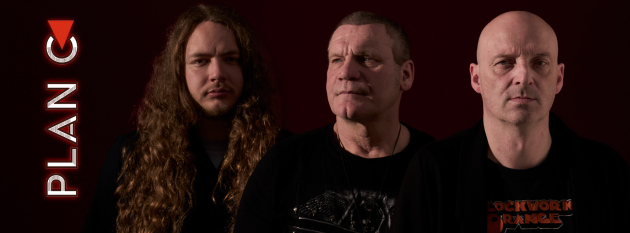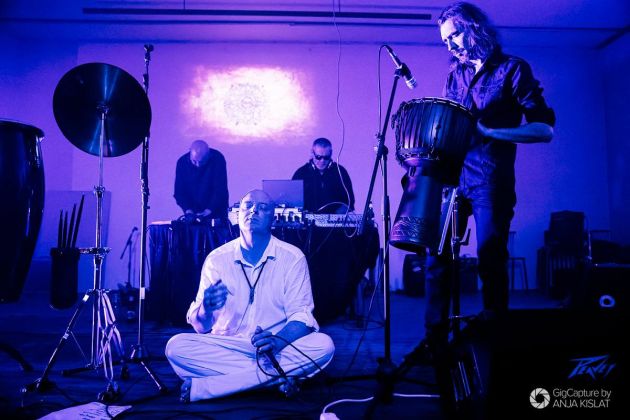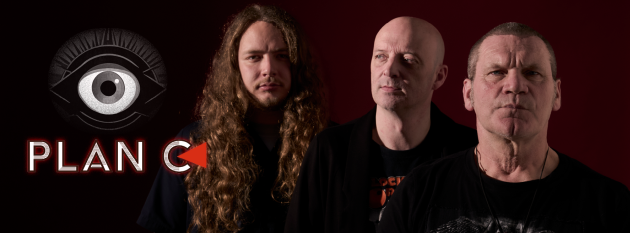 Interview with
Interview with Mika Goedrijk (music, vocals) and Olivier Moulin (music) from This Morn’ Omina & Plan C
Two projects, one creative pulse - that of Mika Goedrijk, a visionary whose music continues to challenge the boundaries between ritual and rebellion. On one side stands THIS MORN’ OMINA, a long-standing force of rhythmic mysticism, meditative yet fiercely physical, weaving trance, tribal, and industrial textures into sonic rituals of transcendence. On the other, PLAN C, born from a world in disarray- sharp, defiant, and unflinchingly direct.
Both inhabit the same creative universe yet radiate entirely different frequencies. In this conversation, Goedrijk reflects on duality - the contemplative and the confrontational, the sacred and the immediate. We discuss resilience, transformation, and creative renewal, the ways sound mirrors chaos, and how “ritual musick,” as he once called it, remains a living dialogue between body, mind, and spirit. What follows is a deeply personal exchange about surviving collapse, reclaiming artistic integrity, and composing not just from inspiration, but from confrontation - with the self, the world, and the ghosts that still whisper through the machines.
Reflections of Darkness [RoD]: Both THIS MORN’ OMINA and PLAN C emerge from the same creative source, yet they channel very different energies - one meditative and ritualistic, the other direct and impulsive. How do you personally separate these worlds when you compose? Or do they in some way feed into each other?
Mika & Olivier: Both are part of the same creative world. PLAN C is just more “in your face” whilst THIS MORN’ OMINA can be contemplative on the surface. They interact with each other, bounce, flip and merge with a common desire to be born creatively.
RoD: Both ‘Omm of Life’ and ‘Play Again’ seem to share a magnetic undercurrent - that primal pulse that drives the body as much as the mind. There’s a sense of trance and tension, reflection, and propulsion, coexisting in both worlds. How conscious are you of this physical energy when composing - is it instinct, design, or something that simply appears when the music finds its own frequency?
Mika & Olivier: We are very conscious of is going on around us. PLAN C is a very apt description of what we have seen / experienced in the last few years up until the state of affairs now. A world in turmoil, well that gives a lot inspiration to write about, hence ‘Play Again’. A world which also shows / holds a different possible outcome if we get together and give it our best, hence ‘Omm of Life’. Both worlds coexist at the same time. We hold up a mirror. Not that people always like its reflection, but you get what you ask for. No refunds later.
RoD: I once heard someone describing THIS MORN’ OMINA’s music as “ritual musick.” In contrast, PLAN C sounds like a Post-Industrial wake-up call - urgent, physical, confrontational. Is PLAN C the necessary counterbalance to the transcendence of THIS MORN’ OMINA - a reminder to stay grounded in chaos?
Mika & Olivier: I actually coined the term “ritual musick” when I started in 1996. THIS MORN’ OMINA does have a kind of urgency, but with a reflective twist. A moment of pondering before uttering a sentence, if you will. In these moments is where the ritual of re-asserting values, connecting to deeper meanings, lies. A musical language comes into existence where the listener can participate in this ritual and open up spiritual links with the entities round us. PLAN C does exactly the same thing, but a lot more brutal. We do not want any dilly-dallying within PLAN C.

RoD: The concept of PLAN C suggests resilience - the ability to start again, to act despite failure. What does this idea mean to you personally? Is it survival, rebellion, or transformation? ‘Play Again’ carries a tone of liberation - as if each track is an act of reclaiming control, of refusing paralysis. Was this record written as a response to any personal or collective exhaustion? Tracks like ‘Tuesday’s Skeleton’ and ‘Nightlife’ pulse with human tension - synths beats, vocals - yet beneath the aggression there’s a strange tenderness. Do you believe intensity and sensitivity can coexist within the same rhythm?
Mika & Olivier: Allow us to answer these three questions in one response as context matters. When you are dealing with people who are ego-first, their own agenda but with zero creative output, combined with a feeble / meek “centre” all their faux glistening goes away quickly when confronted with reality. The pandemic was instrumental in showing true nature of many.
So, I / we shut it all down (tmo / sygo cries / powder pussy / les nuits blanches/...) for my / our (creative) sanity. It was a tough period and a lot of it came with consequences. But Olivier and I did not relent and started again to create. We went back to the essence. Spending 10 months in a cold winter with whirlwinds of voices around us. Working on ideas... no real “plan”. Inspired by what we saw happening / unfolding. At times, it felt like living a nightmare. ‘Tuesday’s Skeleton’ was the first track that came out of PLAN C, and describes very accurately how someone close to us, with all the great ideas, didn’t realize (or was unable to) that if you want to able to communicate with the rest of world through your creativity, you need to connect to the world first.
No number of opiates is going to help you out there, if you cannot bear the sometimes-harsh reality that things inevitably fall apart and picking up pieces is a waste of time. We rehearsed on a Tuesday, hence the title. We helped him on all fronts. But to no avail. Some people cannot bear the look in the mirror. But this became PLAN C in a positive way. Hence our slogan “Whatever life throws at you. There is always a plan. PLAN C”. A bit tongue in cheek in French but the name stuck and we are proud of it. With Maël as a new creative force within PLAN C, I guess we kind of have a plan. But mutual confidence (and added energy from Pierre, Léa and Sam) led to the rebirth of THIS MORN’ OMINA. An event which was celebrated with the ‘Omm of Life’ EP inspired by my partner.
RoD: In THIS MORN’ OMINA’s ‘Omm of Life’, the sense of time dissolves - it’s almost an auditory meditation. How do you achieve that feeling of suspension through production and rhythm? Is it purely structural, or does it begin from a state of mind?
Mika & Olivier: A state of mind. Not really definable. It feels like a dream-state. Fully aware of your surroundings but still detached, far away, a personal room with an outward view on what is going on behind “huis clos”. An idea which can be anything, a sound, a word, an event, a visual triggers the initial “chaos” of creation and with delving deeper into the themes over time it starts to form into something cohesive, something other people can relate to as well. The suspension comes from not really knowing where it is all going. I personally love the feeling of uneasiness in that part of the process as it is the “anything is possible” - feeling that drives you to completing, finishing something what once was just a fleeting thought.

RoD: Your creative universe often feels like it operates outside linear time - ancient and futuristic at once. How consciously do you think about temporality and decay when you create?
Mika & Olivier: Time is irrelevant to me personally. We are all children of the universe, and even though there is a perception of time within it through the lens of science, our limited physical life-times cannot hold a candle against it. Our spiritual life-times however, as they are all intertwined, are outside of time, hence the effortless connection between what is perceived as “past” of “future”’. My fourth album ‘The future has taken root in the present’ is what I consider a good auditory guide on this.
RoD: ‘Play Again’ closes with ‘Into Your Space’ - a track that feels both intimate and confrontational. Is that title an invitation, or a warning?
Mika & Olivier: Actually both. But it is defiant. As our experiences made us more so than ever before. We took our band aids off and we take yours off too. Just be ready for the ripping.
RoD: Both THIS MORN’ OMINA and PLAN C feature striking collaborations - from Gin Devo to Jana Komaritsa. What do you look for in a creative partner, and how do these voices expand or challenge your own artistic language?
Mika & Olivier: Working together with other genuine creative minds gives a new perspective on what you do inside your own bubble. With people like Gin or Jan Dewulf (also feat. guest vocals on a new single) it becomes part of a natural flow, where unforeseen things come together. A great sensation if and when it works out.
RoD: Finally, both projects seem to explore what it means to feel alive - through ritual, repetition, movement, or noise. If you were to describe the emotional core that unites THIS MORN’ OMINA and PLAN C, what would it be? A heartbeat, a scream, or silence?
Mika & Olivier: The rhythmic thump of a heartbeat propelled by screams with intermittent short moments of pause and silence. You know, life, as we humans experience it. Thank you for these great questions, making us think twice about their deserved answers. Peace, love, unity and respect.
Live Picture by Anja Kislat




